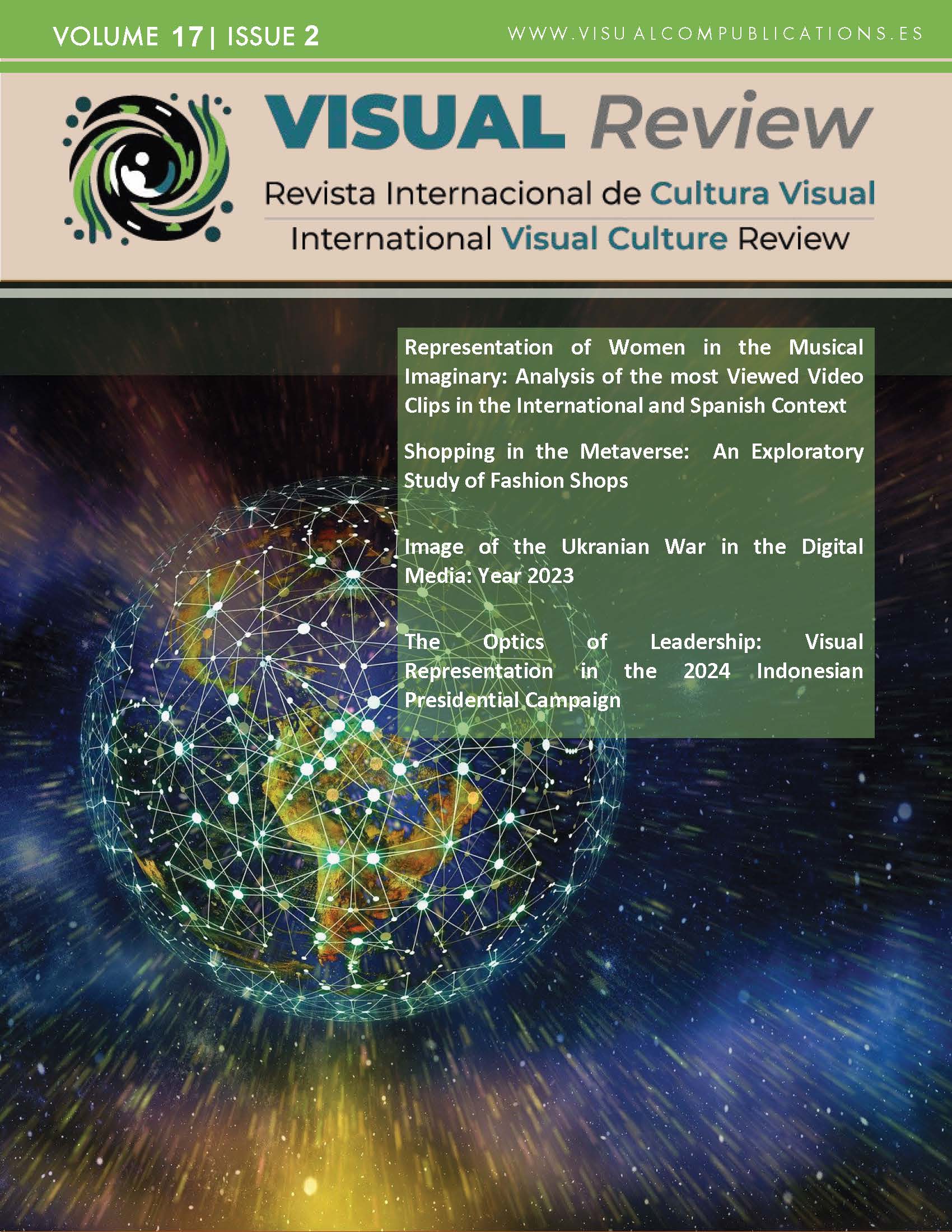The Representation of Women in the Musical Imaginary
Analysis of the most Viewed Video Clips in the International and Spanish Context
DOI:
https://doi.org/10.62161/revvisual.v17.5704Keywords:
Music Video, Music Industry, Gender Sterotypes, Feminist Theory and Media, YouTube, Sustainability, SexismAbstract
The video clip is the most widely consumed audiovisual format today and is particularly popular with young people. These videos offer content full of stereotypes, including gender stereotypes. It is therefore of particular interest to analyse the image of women portrayed in these clips. Therefore, the 300 most viewed video clips worldwide and the 300 music videos of Spanish origin with the most views on YouTube were analysed. The analysis confirmed that the image of women in music videos is more sexualised and denigrated than that of men.
Downloads
Global Statistics ℹ️
|
1186
Views
|
685
Downloads
|
|
1871
Total
|
|
References
Álvarez-Cueva, P., Figueras-Maz, M., & Medina-Bravo, P. (2021). Evolución de la heteronormatividad a partir de una categorización de los estereotipos de género. Análisis de los videoclips musicales más populares. El Profesional de la Informacion. https://doi.org/10.3145/epi.2021.sep.01 DOI: https://doi.org/10.3145/epi.2021.sep.01
Arnold, G. Cookney. D., Fairclough, K. & Goddard, M. (2017): Music/Video Histories. Aesthetics. Media. Nueva York: Bloomsbury Academic. DOI: https://doi.org/10.5040/9781501313943
Aubrey, J. S. & Frisby, C. M. (2011). Sexual Objectification in Music Videos: A Content Analysis Comparing Gender and Genre. Mass Communication and Society. 14(4). 475–501. https://doi.org/10.1080/15205436.2010.513468 DOI: https://doi.org/10.1080/15205436.2010.513468
Baños-González, M., Canorea Tiralaso, H. y Rajas Fernández, M. (2020). La difusión del vídeo musical en YouTube. Análisis de la capacidad viral del videoclip. Revista Latina De Comunicación Social. (77). 117–141. https://doi.org/10.4185/RLCS-2020-1452 DOI: https://doi.org/10.4185/RLCS-2020-1452
Barlovento (2024). Consumo Internet – Septiembre 2024. https://acortar.link/vURII9
Bas-Peña, E. & Pastor-Bravo, C. (2024). Violencia de género y violencia sexual en las canciones de reggaetón. Estudio cualitativo. Pedagogia Social Revista Interuniversitaria. 45. 81-97.
https://doi.org/10.7179/psri_2024.45.04 DOI: https://doi.org/10.7179/PSRI_2024.45.04
Bell, B. T., Lawton, R., & Dittmar, H. (2007). The impact of thin models in music videos on adolescent girls’ body dissatisfaction. Body Image, 4(2), 137-145. https://doi.org/10.1016/j.bodyim.2007.02.003 DOI: https://doi.org/10.1016/j.bodyim.2007.02.003
Benavides-Morillo, C. (2007). Los estereotipos femeninos en los videos musicales del género reggaeton: una cuestión de género. Estudios Digital, 20, 184-198. https://doi.org/10.15517/re.v0i20.24064
Bourdieu, P. (2002). The forms of capital. In N. W. Biggart (Ed.), Readings in economic sociology (pp. 280-291). Blackwell Publishers Ltd. https://doi.org/10.1002/9780470755679.ch15 DOI: https://doi.org/10.1002/9780470755679.ch15
Cross, I. (2001). Music. Mind and Evolution. Psychology Of Music. 29(1). 95-102.
https://doi.org/10.1177/0305735601291007 DOI: https://doi.org/10.1177/0305735601291007
Erikson, E. H. (1994). Identity and the life cycle. WW Norton.
Flynn, M. A., Craig, C. M., Anderson, C. N. & Holody, K. J. (2016). Objectification in popular music lyrics: An examination of gender and genre differences. Sex Roles. 75(3-4). 164-176. https://doi.org/10.1007/s11199-016-0592-3 DOI: https://doi.org/10.1007/s11199-016-0592-3
Freeman, C. (2019). Filming female desire: queering the gaze of pop music videos. Cultural Studies. 34(6). 1007-1032. https://doi.org/10.1080/09502386.2019.1704039 DOI: https://doi.org/10.1080/09502386.2019.1704039
Frith, S. (1981). Sound Effects: Youth. Leisure. and the Politics of Rock. Pantheon. Nueva York.
Gálvez, C. M. (2020). El mal querer (2018) de Rosalía: semiótica del videoclip «Di mi nombre (Cap. VIII: Éxtasis)». Popular Music Research Today Revista Online de Divulgación Musicológica. 2(1). 5. https://doi.org/10.14201/pmrt.20824 DOI: https://doi.org/10.14201/pmrt.20824
Gértrudix-Barrio, M. y Gértrudix-Barrio, F. (2010). The utility of musico-visual formats in teaching. [La utilidad de los formatos de interacción músico-visual en la enseñanza]. Comunicar. 17(34). 99-107. https://doi.org/10.3916/C34-2010-02-10 DOI: https://doi.org/10.3916/C34-2010-02-10
Gill, R. (2007). Postfeminist media culture: Elements of a sensibility. European Journal of Cultural Studies. 10(2). 147-166. https://doi.org/10.1177/1367549407075898 DOI: https://doi.org/10.1177/1367549407075898
Gorissen, S. (2021). Contesting Hegemonic Masculinity Through Profeminist Passing on The Police’s Outlandos d’Amour. Women’s Studies In Communication. 44(4). 586-610.
https://doi.org/10.1080/07491409.2021.1881003 DOI: https://doi.org/10.1080/07491409.2021.1881003
Gramsci, A. (1977). Antología. Siglo Veintiuno XXI.
Grijalba, N. (2011). La nueva morfología de los videoclips en la era de Youtube. En F. García. & M. Rajas (Eds.). Narrativas audiovisuales: mediación y convergencia (pp. 49-64). España: Icono 14 editorial.
Guarinos, V. (2012). Estereotipos y nuevos perfiles de mujer en la canción de consumo. De la romántica a la mujer fálica. Cuestiones de Género/Cuestiones de GéNero, 7, 297. https://doi.org/10.18002/cg.v0i7.915 DOI: https://doi.org/10.18002/cg.v0i7.915
Hormigos, J. & Martín Cabello, A. (2008). La construcción de la identidad juvenil a través de la música. Revista Española De Sociología. (4). https://acortar.link/32gILs
Illescas-Martínez, J. (2015). La dictadura del videoclip industria musical y sueños prefabricados. El viejo topo.
Illescas-Martínez, J. (2017). El contenido del videoclip dominante como reproductor cultural e ideológico. Revista Mediterránea de Comunicación. 8(2). 85.
https://doi.org/10.14198/medcom2017.8.2.6 DOI: https://doi.org/10.14198/MEDCOM2017.8.2.6
Jorge Alonso, A.M., Samaniego Espinosa, J. & Vega Durán, S. (2020). Feminismo Mainstream: la representación de la mujer y su empoderamiento en el videoclip. En Sierra Caballero F.. Montero Sánchez. D. & Candón-Mena. J. (Eds.). Ciberactivismo. Libertad y Derechos Humanos. Retos de la democracia informativa. Actas del XI Congreso Internacional ULEPICC (pp. 299-327).
Lieb, K. (2018). Gender. Branding. and the Modern Music Industry. The Social Construction of Female Popular Music Stars. Routledge. DOI: https://doi.org/10.4324/9781315160580
López-Maestre, M. D. (2021). Canciones. sexismo y violencia de género: un análisis crítico del discurso con perspectiva feminista. Pragmalingüística. (29). 280–304. https://doi.org/10.25267/Pragmalinguistica.2021.i29.15 DOI: https://doi.org/10.25267/Pragmalinguistica.2021.i29.15
Martínez Cano, S. (2017). Las divas del pop y la identidad feminista: reivindicación. contradicción y consumo cultural. Revista de Investigaciones Feministas 8(2). 475-492. https://doi.org/10.5209/INFE.55079 DOI: https://doi.org/10.5209/INFE.55079
Mata-Núñez, A. (2024). Representaciones de género en el videoclip actual. La imagen de las mujeres en el reguetón femenino. Zer-Revista de Estudios de Comunicación. 29(56). 223-240.
https://doi.org/10.1387/zer.25031 DOI: https://doi.org/10.1387/zer.25031
Mulvey, L. (1975). Visual Pleasure and Narrative Cinema. Screen, 16(3), 6-18. https://doi.org/10.1093/screen/16.3.6 DOI: https://doi.org/10.1093/screen/16.3.6
O’Brien, L. (2003). She Bop II: The Definitive History of Women in Rock. Pop and Soul: The Definitive History of Women in Rock. Pop and Soul. Continuum.
Paz Gil, I., Prado Román, A. & Prado Román, M. (2024). Sostenibilidad organizacional. Madrid: Ediciones Pirámide.
Pérez-Rufí, J. P. (2017). Mujeres en el videoclip: La representación de la mujer en los vídeos musicales de Diane Martel. Prisma Social: Revista de Investigación Social. 2. 202-232. https://acortar.link/xRkZNu
Presencio Herrero, A., Díez Hermano, S. & García Nieto, M. T. (2021). Análisis de la representación sexista de la figura de la mujer: estudio de caso en los videoclips más vistos en YouTube España en 2020. Cuestiones de Género: de la igualdad y la diferencia. (16). 487–510. https://doi.org/10.18002/cg.v0i16.6946 DOI: https://doi.org/10.18002/cg.v0i16.6946
Rasmussen, E. E. & Densley. R. L. (2017). Girl in a country song: Gender roles and objectification of women in popular country music across 1990 to 2014. Sex Roles: A Journal of Research. 76(3-4). 188–201. https://doi.org/10.1007/s11199-016-0670-6 DOI: https://doi.org/10.1007/s11199-016-0670-6
Ruiz Muñoz, M. J., Durán Manso. V. y Maya Retamar. R. D. L. (2024). Representaciones de género. igualdad y diversidad en los medios de comunicación: (1 ed.). Barcelona (España). Editorial UOC.
Sánchez-Vizcaíno, M. C. y Fonseca-Mora, M. C. (2019). Videoclip y emociones en el aprendizaje de Español como Lengua Extranjera. Círculo de Lingüística Aplicada a la Comunicación. 78. 255-286. https://doi.org/10.5209/clac.64381 DOI: https://doi.org/10.5209/clac.64381
Sánchez-Vizcaíno, M., Cancelas-Ouviña, L., & Fonseca-Mora, M. (2023). A multimodal analysis for an updated vision of women in music videos. Observatorio (OBS*), 17(3). https://doi.org/10.15847/obsobs17320232229 DOI: https://doi.org/10.15847/obsOBS17320232229
Sedeño Valdellós, A. M. (2002). Música e imagen: aproximación a la historia del vídeo musical. Área Abierta. Revista de comunicación audiovisual y publicitaria. 3(2). https://acortar.link/Lu3wT6
Selva Ruiz, D. (2014). El videoclip: comunicación comercial en la industria musical. Alfar.
Sibaja Cumplido, R. (2024). Mujer y música: representación de las artistas en el videoclip. En Durán Manso, V., De la Maya Retamar, R. & Ruiz Muñoz, M.J. (coord.). Representaciones de género. igualdad y diversidad en los medios de comunicación (pp.101-110). Editorial UOC.
Soler-Campo, S. y Oriola-Requena, S. (2019). Música. identidad de género y adolescencia: Orientaciones didácticas para trabajar la coeducación. Epistemus. Revista De Estudios En Música. Cognición Y Cultura. 7(2). 008. https://doi.org/10.24215/18530494e008 DOI: https://doi.org/10.24215/18530494e008
Tiggemann, M., & Slater, A. (2003). Thin ideals in music television: A source of social comparison and body dissatisfaction. International Journal Of Eating Disorders, 35(1), 48-58. https://doi.org/10.1002/eat.10214 DOI: https://doi.org/10.1002/eat.10214
United Nations (2024). Sustainable Development Goals. https://www.un.org/sustainabledevelopment/es/gender-equality/
Venegas, M. (2010). Educar las relaciones afectivo sexuales. prevenir las diferentes formas de violencia de género. Trabajo Social Global-Global Social Work. 1(2). 162–182. https://doi.org/10.30827/tsg-gsw.v1i2.909 DOI: https://doi.org/10.30827/tsg-gsw.v1i2.909
Viñuela Suárez, E. (2007). Industria musical. televisión y producción audiovisual: veinte años de interacción mediática en el mercado musical español (1980–2000). Global Media Journal Edición Iberoamericana. 4(7).
Wallis, C. (2011). Performing gender: A content analysis of gender display in music videos. Sex Roles. 64(3-4). 160-172. https://doi.org/10.1007/s11199-010-9814-2 DOI: https://doi.org/10.1007/s11199-010-9814-2
Women's Image Observatory of the Women's Institute (2014) https://acortar.link/ZYEdfN
World Economic Forum (11 de junio de 2024). Global Gender Gap Report 2024. https://acortar.link/6OyM0X
Zallo Elguezabal. R. (2016). Tendencias en comunicación. Cultura digital y poder. Gedisa.
Downloads
Published
How to Cite
Issue
Section
License
Copyright (c) 2025 VISUAL REVIEW. International Visual Culture Review / Revista Internacional de Cultura Visual

This work is licensed under a Creative Commons Attribution-NoDerivatives 4.0 International License.
Those authors who publish in this journal accept the following terms:
-
Authors retain copyright.
-
Authors transfer to the journal the right of first publication. The journal also owns the publishing rights.
-
All published contents are governed by an Attribution-NoDerivatives 4.0 International License.
Access the informative version and legal text of the license. By virtue of this, third parties are allowed to use what is published as long as they mention the authorship of the work and the first publication in this journal. If you transform the material, you may not distribute the modified work. -
Authors may make other independent and additional contractual arrangements for non-exclusive distribution of the version of the article published in this journal (e.g., inclusion in an institutional repository or publication in a book) as long as they clearly indicate that the work was first published in this journal.
- Authors are allowed and recommended to publish their work on the Internet (for example on institutional and personal websites), following the publication of, and referencing the journal, as this could lead to constructive exchanges and a more extensive and quick circulation of published works (see The Effect of Open Access).













